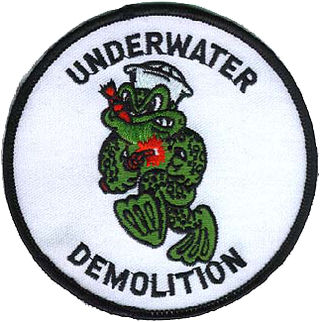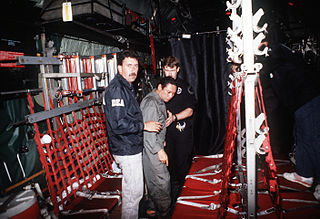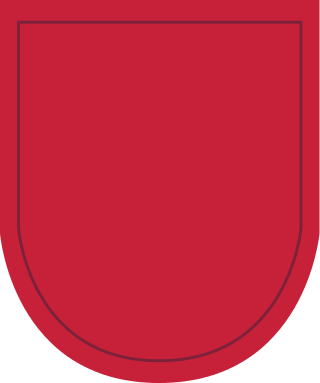
The United States Navy Sea, Air, and Land (SEAL) Teams, commonly known as Navy SEALs, are the U.S. Navy's primary special operations force and a component of the Naval Special Warfare Command. Among the SEALs' main functions are conducting small-unit special operation missions in maritime, jungle, urban, arctic, mountainous, and desert environments. SEALs are typically ordered to capture or kill high level targets, or to gather intelligence behind enemy lines. SEAL team personnel are hand selected, highly trained, and possess a high degree of proficiency in direct action (DA), and special reconnaissance (SR), among other tasks like sabotage, demolition, intelligence gathering, and hydro-graphic reconnaissance, training, and advising friendly militaries or other forces.

Moffett Federal Airfield, also known as Moffett Field, is a joint civil-military airport located in an unincorporated part of Santa Clara County, California, United States, between northern Mountain View and northern Sunnyvale. On November 10, 2014, NASA announced that it would be leasing 1,000 acres (400 ha) of the airfield property to Google for 60 years.

The United States invaded Panama in mid-December 1989 during the presidency of George H. W. Bush. The primary purpose of the invasion was to depose the de facto ruler of Panama, General Manuel Noriega, who was wanted by U.S. authorities for racketeering and drug trafficking. The operation, codenamed Operation Just Cause, concluded in late January 1990 with the surrender of Noriega. The Panama Defense Forces (PDF) were dissolved, and President-elect Guillermo Endara was sworn into office.

The 160th Special Operations Aviation Regiment (Airborne), abbreviated as 160th SOAR (A), is a special operations force of the United States Army that provides helicopter aviation support for special operations forces. Its missions have included attack, assault, and reconnaissance, and these missions are usually conducted at night, at high speeds, low altitudes, and on short notice.

The Underwater Demolition Team (UDT), or frogmen, were amphibious units created by the United States Navy during World War II with specialized non-tactical missions. They were predecessors of the navy's current SEAL teams.

Dover Air Force Base or Dover AFB is a United States Air Force (USAF) base under the operational control of Air Mobility Command (AMC), located 2 miles (3.2 km) southeast of the city of Dover, Delaware. The 436th Airlift Wing is the host wing and runs the busiest and largest air freight terminal in the Department of Defense.

Operation Nifty Package was a United States Delta and Navy SEAL-operated plan conducted in 1989 designed to capture Panamanian leader Manuel Noriega. When Noriega took refuge in the Apostolic Nunciature of the Holy See, deafening music and other psychological warfare tactics were used to convince him to exit and surrender himself.

Naval Air Station Whiting Field is a United States Navy base located near Milton, Florida, with some outlying fields near Navarre, Florida, in south and central Santa Rosa County, and is one of the Navy's two primary pilot training bases. NAS Whiting Field provides training for U.S. Navy, U.S. Marine Corps, Coast Guard, and Air Force student pilots, as well as those of several allied nations. NAS Whiting Field is home to Training Air Wing Five.

Naval Air Station Keflavik (NASKEF) is a United States Navy air station at Keflavík International Airport, Iceland, located on the Reykjanes peninsula on the south-west portion of the island. NASKEF was closed on 8 September 2006, and its facilities were taken over by the Icelandic Defence Agency as their primary base until 1 January 2011, when the Agency was abolished and the base handed over to the Icelandic Coast Guard, which has operated the base until 2017. US forces returned to Keflavik since 2016.

Ramey Air Force Base also known as Borinquen Field, is a former United States Air Force base in Aguadilla, Puerto Rico. It was named after United States Army Air Forces Brigadier General Howard Knox Ramey. Following its closure, it was redeveloped into Rafael Hernandez Airport.
Albrook Air Force Station is a former United States Air Force facility in Panama. It was closed on 30 September 1997 as a result of the Torrijos-Carter Treaties which specified that United States military facilities in the former Panama Canal Zone be closed and the facilities be turned over to the Panamanian government. It was located on the east side of the Panama Canal just south of Fort Clayton and north of the township of Balboa, Panama. Beginning in January 1999, the air field initiated civilian air service as Albrook "Marcos A. Gelabert" International Airport.

The 7th Special Forces Group (Airborne) (7th SFG) (A) is an operational unit of the United States Army Special Forces activated on 20 May 1960. It was reorganized from the 77th Special Forces Group, which was also stationed at Fort Bragg, North Carolina. 7th Group—as it is sometimes called—is designed to deploy and execute nine doctrinal missions: unconventional warfare, foreign internal defense, direct action, counter-insurgency, special reconnaissance, counter-terrorism, information operations, counterproliferation of weapons of mass destruction, and security force assistance. The 7th SFG(A) spends much of its time conducting foreign internal defense, counter-drug, and training missions of friendly governments' armed forces in South, Central, and North America as well as the Caribbean. 7th SFG(A) participated in Operation Urgent Fury in Grenada in 1983, and in Operation Just Cause in Panama in 1989. The 7th SFG(A) has, like all the SFGs, been heavily deployed to Iraq and Afghanistan in the War on Terror. The 7th SFG has lost more SF soldiers in the Global War on Terrorism than any other SFG.

The Panama Defense Forces (Spanish: Fuerzas de Defensa de Panamá; FFDD) formerly the National Guard (of Panama) (Spanish: Guardia Nacional), were the armed forces of the Republic of Panama.
Donald Lewis McFaul was a United States Navy SEAL killed in action at Paitilla Airfield during Operation Just Cause, the 1989 United States invasion of Panama. He was posthumously awarded the Purple Heart and Navy Cross for his heroism during the battle while pulling another SEAL to safety. Only two Navy Crosses were awarded for the 1989 operations in Panama. The Arleigh Burke-class destroyerUSS McFaul (DDG-74) was named to honor him.

Punta Gorda Airport is a public airport three miles east of Punta Gorda, in Charlotte County, Florida. It is owned by the Charlotte County Airport Authority and was formerly called Charlotte County Airport. The airport has mainly been used for general aviation, but has recently seen more scheduled airline service, with flights offered by Allegiant Air to fifty-one destinations.

Albrook "Marcos A. Gelabert" International Airport is a public airport located 1.5 kilometres west of the center of Panama City, in the Panamá Province of Panama. It is on the site of the former Albrook Air Force Station. Previously, the airport was located in the area of Paitilla Punta Paitilla, operating approximately 70 years until January 1999, when the airport moved operations to Albrook. The name was changed to honor the Panamanian aviator Marcos A. Gelabert, whose contributions to Panamanian aviation included founding Panama's first airline and first school for training pilots.

Casey Ryback is a fictional character and action hero from the Under Siege films of the 1990s. Played by Hollywood action star Steven Seagal, Ryback is a chief petty officer, culinary specialist and former Navy SEAL operator with top training in martial arts, explosives, special-weapons and tactics. He appears in the 1992 film Under Siege and its sequel, Under Siege 2: Dark Territory, in 1995.

Imeson Field, also known as Jacksonville Imeson Airport, was the airport serving Jacksonville, Florida, from 1927 until its closing in 1968. It was known as Jacksonville Municipal Airport prior to World War II, Jacksonville Army Airfield when the United States Army Air Forces controlled the facility during World War II, and at its closing the airport was Jacksonville – Thomas Cole Imeson Municipal Airport.
The Battle of Rio Hato Airfield took place as an opening action of the United States invasion of Panama, and was fought between the U.S military and the Panama Defense Forces (PDF) on 20 December 1989. The action saw US paratroopers launch a surprise attack against the PDF at Rio Hato, the largest PDF military base in the country, approximately seventy miles south of Panama City.

The 7th Macho de Monte Infantry Company was an elite infantry battalion of the Panama Defense Forces. Its mascot was the Baird's tapir, from which the company took it name, as in Panama the tapir is called 'Macho de Monte' which translates as 'mountain men'. It was based at the Base Militar "General de Division Omar Torrijos Herrera" in Rio Hato and specialised in guerrilla warfare.

















